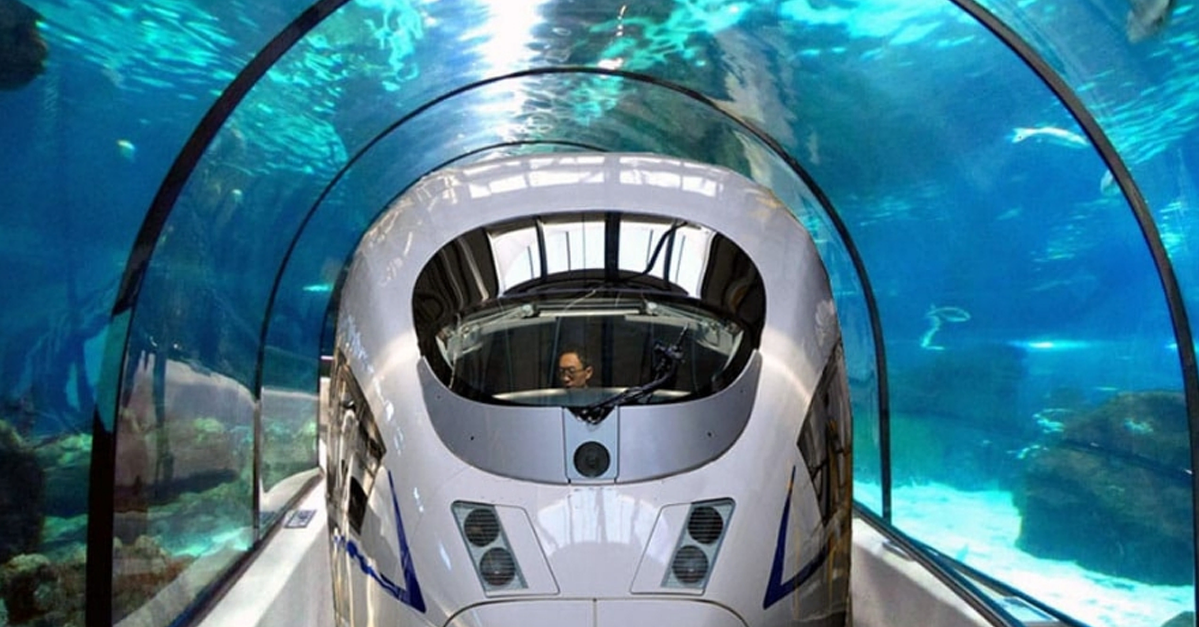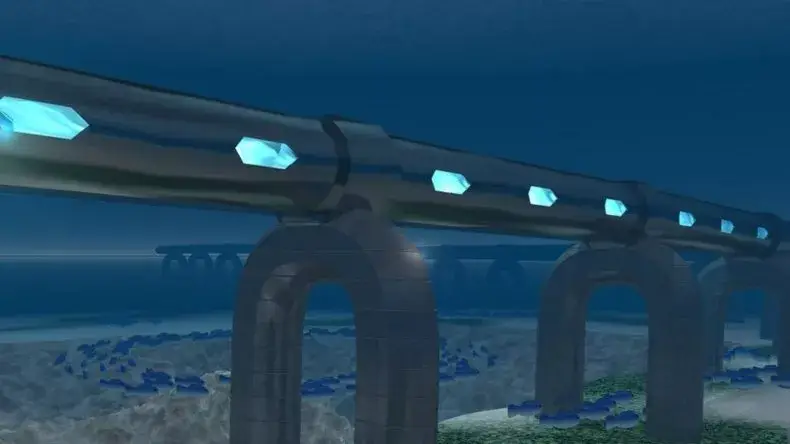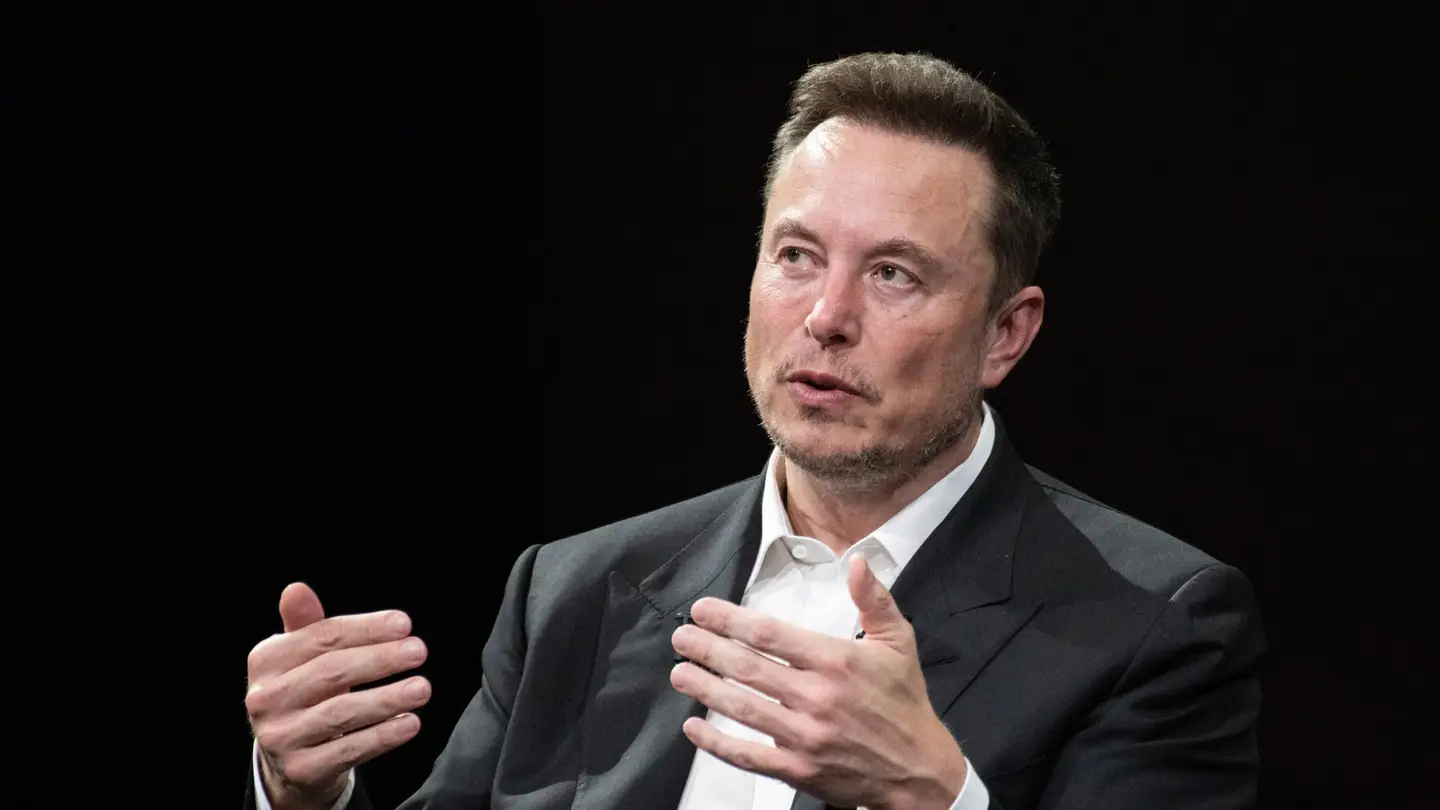Elon Musk and the Vision for a Transatlantic Hyperloop: Revolutionizing Travel or a Pipe Dream?

Imagine stepping aboard a cutting-edge train in New York, settling into your seat, and arriving in London just under an hour later—no jet lag, no airport delays, and, most importantly, zero carbon emissions. This visionary idea, known as the Transatlantic Tunnel, has captivated the imaginations of scientists, engineers, and visionaries for decades. It proposes connecting two of the world’s most iconic cities—New York and London—via an underwater tunnel that could house ultra-fast trains, traveling at speeds exceeding 3,000 mph. The train would be propelled through vacuum tubes using magnetic levitation (maglev) technology, potentially revolutionizing global travel.

The transatlantic tunnel, estimated to cost $20 trillion, could cut travel between London and New York to under an hour, reshaping global connectivity. (CREDIT: CC BY-SA 4.0)
The idea, while audacious, offers a tantalizing glimpse into the future of transportation. However, the estimated cost of building such a tunnel—a staggering $19.8 trillion—has raised many eyebrows, even among the most optimistic futurists. Enter Elon Musk, the visionary behind Tesla, SpaceX, and The Boring Company. Musk has claimed that his tunneling company could build the Transatlantic Tunnel for “1,000 times less” than the projected cost. But is Musk’s assertion grounded in reality, or is it simply another instance of his seemingly over-the-top ambitions? In this article, we explore the feasibility, challenges, and broader implications of the Transatlantic Tunnel—an idea that could either redefine transportation or remain a distant pipe dream.

Credit: X
What is the Transatlantic Tunnel?
The Transatlantic Tunnel isn’t just a transportation proposal; it is a concept that challenges the very nature of how we think about long-distance travel. Using advanced vacuum-sealed tubes and maglev technology, the idea involves creating a high-speed train system capable of traveling at speeds greater than 3,000 mph—far beyond the capabilities of today’s fastest trains or airplanes. The train would glide above the track in a near-frictionless environment, allowing for incredibly high speeds. Vacuum tubes would reduce air resistance, enabling the train to reach these extraordinary speeds.
Key Features and Benefits
- Unprecedented Speed: The Transatlantic Tunnel promises travel times that could cut the duration of a transatlantic flight from over 7 hours to just under an hour. For example, a journey from New York to London could take just 47 minutes—significantly faster than any current flight.
- Sustainability and Environmental Impact: Powered entirely by renewable energy sources such as solar and wind, the system could be one of the most energy-efficient and eco-friendly transportation solutions available, drastically reducing the carbon footprint compared to traditional air travel.
- Economic Impact: Faster travel between two of the world’s largest economic powerhouses could spur new opportunities for business, tourism, and international cooperation, contributing to economic growth and greater global interconnectedness.
- Enhanced Connectivity: In addition to New York and London, a network of such tunnels could eventually link other global cities, creating a vast network of high-speed travel routes that would fundamentally alter the global transportation landscape.
However, these exciting possibilities are far from assured. The vision for the Transatlantic Tunnel requires overcoming a long list of technological, financial, and logistical obstacles that make it one of the most ambitious infrastructure projects ever conceived.

A rendering of a proposal for the Transatlantic Tunnel. While the concept has existed for a while, no viable design has been reached yet. (CREDIT: Ricardo Broch)
Learning from the Channel Tunnel: A Milestone in Tunneling
Before diving into the challenges of constructing the Transatlantic Tunnel, it’s useful to look at existing tunneling projects as case studies. The most notable of these is the Channel Tunnel, which links Folkestone in Kent, England to Coquelles in Pas-de-Calais, France.
The Channel Tunnel at a Glance
- Length: 31 miles (50.5 km)
- Construction Timeline: 6 years (1988–1994)
- Cost: Approximately $21 billion (adjusted for inflation)
- Purpose: High-speed passenger and freight transport
While the Channel Tunnel was a monumental engineering achievement, its scale is relatively small compared to the Transatlantic Tunnel. The Channel Tunnel runs for 31 miles beneath the English Channel. In comparison, the Transatlantic Tunnel would span over 3,100 miles—more than 100 times longer than the Channel Tunnel.
Key Insights from the Channel Tunnel
- Timeline: The Channel Tunnel, despite its size, took 6 years to complete with cutting-edge technology. Extrapolating this timeline to the Transatlantic Tunnel, it would take centuries to finish. The estimated construction period of 782 years is a daunting prospect.
- Engineering Feats: The Channel Tunnel’s success hinged on overcoming the challenges of underwater tunneling, including issues related to water pressure, geological conditions, and the threat of seismic activity. The Transatlantic Tunnel would face these same challenges, but on a much larger and more complex scale.
Major Challenges in Building the Transatlantic Tunnel
1. Engineering and Structural Obstacles
Tunneling under the Atlantic Ocean introduces numerous engineering challenges that require sophisticated solutions.
- Ocean Depth and Pressure: The Atlantic Ocean averages about 12,000 feet (3,600 meters) in depth, with some areas reaching even deeper. At these depths, the pressure exerted by the water could crush conventional tunneling structures unless advanced materials and designs are developed.
- Tectonic Shifts and Earthquakes: The Atlantic floor is seismically active, meaning the tunnel would need to withstand the forces generated by earthquakes and tectonic shifts. Any structural weaknesses could cause catastrophic failures in the tunnel.
- Material Science: Current construction materials may not be able to withstand the extreme conditions of the ocean floor for long periods. Developing new materials capable of withstanding immense pressure, corrosion, and seismic activity is critical to the success of the project.
2. Cost and Funding
At an estimated cost of $19.8 trillion, the Transatlantic Tunnel is beyond the reach of any single nation or private entity. The high costs would encompass a wide range of expenses, including:
- Tunneling Equipment: Developing and deploying the necessary machinery to dig such a long tunnel, especially under the ocean, would cost billions of dollars.
- Materials: Materials to construct the tunnel, such as steel, concrete, and specialized materials to handle extreme underwater conditions, would be expensive.
- Labor: The cost of the human workforce would also be a factor. Skilled labor and engineers would need to be sourced globally, and large-scale construction projects often experience cost overruns.
Funding such a massive infrastructure project would require international cooperation. Governments and private companies, including those specializing in transportation, construction, and renewable energy, would need to contribute billions of dollars. Public-private partnerships (PPPs) might be the most feasible route for financing, though they would require unprecedented levels of coordination and trust.
3. Safety Concerns
Safety is one of the most critical factors in any transportation infrastructure project, and the Transatlantic Tunnel would be no exception. Some of the primary safety challenges include:
- Flooding: A breach in the tunnel could lead to catastrophic flooding. The tunnel would need to be equipped with fail-safe mechanisms to prevent or mitigate such risks, such as watertight seals, automated detection systems, and emergency evacuation routes.
- Emergency Evacuation: Evacuating passengers from a submerged tunnel would be an incredibly difficult task. New technologies such as air evacuation pods and underwater escape systems would need to be developed to ensure the safety of those traveling in the tunnel.
- Hazardous Byproducts: The maglev and vacuum systems used in the tunnel could produce harmful byproducts, such as explosive gases, which would need to be safely managed. Ensuring the proper handling and disposal of such materials is crucial.
4. Technological Gaps
While the technologies proposed for the Transatlantic Tunnel—vacuum tubes and maglev trains—are highly promising, they remain largely experimental. The Hyperloop concept, championed by Musk, has been demonstrated on smaller test tracks, but it remains years, if not decades, from commercialization. Scaling up these technologies to span an ocean is a monumental challenge.
Elon Musk’s Boring Company: Can It Deliver?
Elon Musk’s reputation for ambitious ventures precedes him.
From developing electric cars with Tesla to creating reusable rockets with SpaceX, Musk has a knack for turning futuristic ideas into reality. His tunneling venture, The Boring Company, aims to revolutionize infrastructure by creating faster, cheaper, and more sustainable ways to dig tunnels.
Innovations in Tunnel Construction
- Advanced Tunnel Boring Machines (TBMs): These machines are designed to dig faster and more efficiently than traditional tunnel-boring equipment, which could lower construction costs significantly.
- Cost Reduction: The Boring Company aims to reduce tunneling costs through automation, more efficient designs, and the use of electric-powered equipment to minimize energy consumption and environmental impact.
- Sustainability: Musk emphasizes that his tunneling operations will be powered by renewable energy, further reducing the environmental impact of tunnel construction.

Elon Musk, the billionaire entrepreneur and founder of The Boring Company, has championed vacuum tube technology. (CREDIT: CC BY-SA 4.0)
Despite these innovations, experts remain skeptical about Musk’s ability to deliver a project of such scale and complexity. Tunneling under the ocean requires specialized knowledge, materials, and technologies that may not yet be available, and critics question whether Musk’s optimism is founded in reality.
Alternative High-Speed Travel Solutions
While the Transatlantic Tunnel remains a distant dream, other high-speed travel solutions are actively being developed and could provide an alternative to traditional air travel.
Hyperloop Systems
Elon Musk’s Hyperloop is a futuristic transportation system that involves high-speed pods traveling through vacuum tubes. Companies like Virgin Hyperloop are actively developing this concept, with shorter routes like Los Angeles to San Francisco and Dubai to Abu Dhabi already under consideration. While Hyperloop technology has yet to be deployed on a commercial scale, it remains a promising solution for high-speed travel.
Supersonic Jets
Companies like Boom Supersonic are working on developing supersonic jets that can drastically reduce flight times. Their proposed aircraft, the Overture, could fly from New York to London in just 3.5 hours—half the time it takes today.
Electric and Hydrogen-Powered Aircraft
In addition to supersonic jets, companies like Eviation Aircraft are working on electric planes, which could offer a cleaner, more sustainable alternative to current air travel. Similarly, hydrogen-powered planes hold promise for reducing the aviation sector’s carbon emissions.
The Promise of a Transatlantic Hyperloop
While the Transatlantic Tunnel is far from becoming a reality, its potential benefits remain significant:
- Economic Integration: Faster travel between the U.S. and Europe could significantly enhance trade, tourism, and cross-border collaboration.
- Environmental Impact: A system powered by renewable energy could revolutionize global transportation by drastically reducing emissions and dependence on fossil fuels.
- Technological Advancements: A project of this
magnitude would accelerate progress in fields like materials science, renewable energy, and transportation engineering.
What the Future Holds
While the Transatlantic Tunnel remains a futuristic idea, its vision represents the endless potential of human ingenuity. It serves as a reminder of the possibilities that lie ahead if we dare to think big and take risks. Elon Musk’s confidence in the ability of The Boring Company to revolutionize tunnel construction adds a layer of intrigue to the concept. However, even with rapid advancements in technology, the challenges of building such a structure under the ocean remain formidable.
For now, the Transatlantic Tunnel represents the next frontier in high-speed travel, inspiring both engineers and dreamers alike. Whether it becomes a reality or not, its concept will likely continue to shape the future of transportation for years to come.
Featured Image Credit: CC BY-SA 4.0, X, Ricardo Broch






